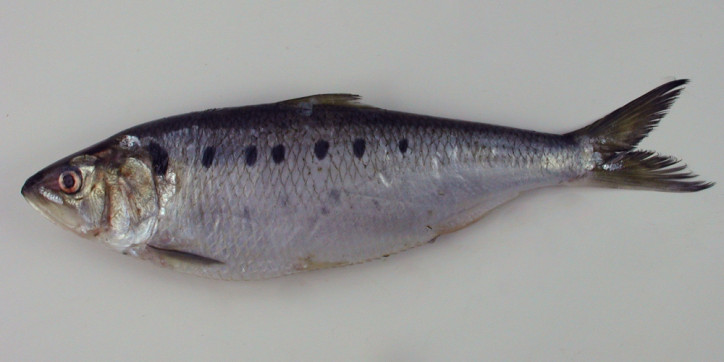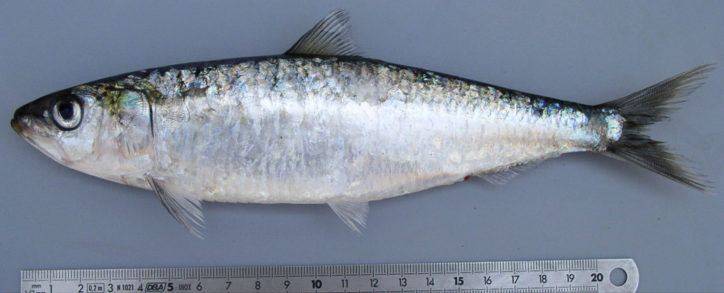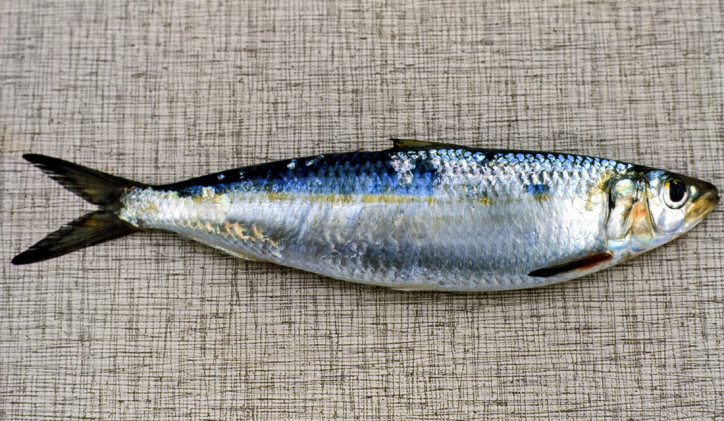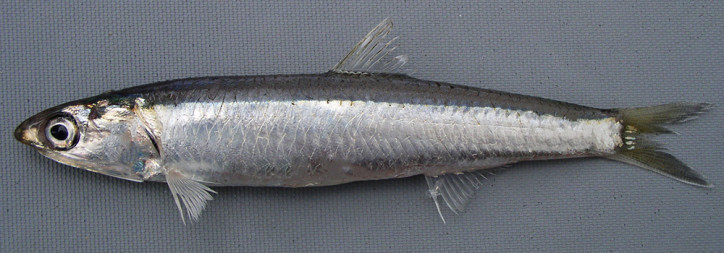The Clupeiformes order is the only fish order comprising the Clupeomorpha superorder. Clupeiformes are the inhabitants of the sea and fresh water.
These pelagic fish feed mainly on plankton. The order comprises 7 families and 405 species, many of which have commercial value.
In the Adriatic Sea, there are 5 species of the Clupeiformes order, representatives of 2 families, including Clupeidae and Engraulidae.

(“Herring”. 1918. Kuzma Petrov-Vodkin.)
There is a great terminological confusion in people’s minds because of colloquial names and free combination of names of fish of the Clupeiformes order. To be accurate, herring (Clupea), is a fish genus of the Clupeidae family, commercially valuable fish inhabiting the northern part of the Atlantic and Pacific Oceans, as well as in the Arctic Ocean, including the most famous species of Pacific and Atlantic herring.
Herring played a significant role in the history of Europeans. In the 13-14th centuries, herring used to be one of the main fish dishes in the north-western part of Europe. Although they’ve known about herring In the Mediterranean countries since ancient times, it wasn’t that popular, and, as it was mentioned before, it didn’t inhabit the southern seas.
European sprat (Sprattus sprattus) is the closest relative of the herring, belonging to the same Clupeinae subfamily, inhabiting the Adriatic Sea.

(European sprat. Photo by © Hans Hillewaert. flickr.com/photos/bathyporeia)
European sprat is a pelagic schooling fish inhabiting the depths of 10-150 meters. Sometimes it enters the mouths of rivers. The maximum recorded length is 16 cm; specimens up to 12 cm long are more common. It feeds on plankton crustaceans. It is a permanent inhabitant of the Adriatic Sea, which is the target of commercial fishing.
When we buy canned sprats today, it doesn’t necessarily mean that the sprats are really inside the can. It used to be like this before, but gradually they began to produce canned fish from other small-sized fish of the Clupeidae family, including Atlantic herring and others, under this name. The main thing is that the recipe remained the same – when cooking “sprats”, small fish is smoked without any pre-cooking, and then canned in oil. As a result, the word “sprats” usually means any smoked canned fish from small fish in oil.
The fish of the Alosinae subfamily of the Clupeidae family are known to almost every fisherman, who catches fish with spinning rods. However, many of them don’t even guess what these representatives of ichthyofauna look like and that they even exist in nature. The Alosinae subfamily is called shads in English, and “shad” is the way one of the most popular forms of plugs and soft plastic lures is called.
Two species of the Alosinae subfamily (one of the shad genus and one of the sardine genus) inhabit the Adriatic Sea, but adriaticnature will tell you about three species, and here’s why.
Twaite shad (Alosa fallax) didn’t get much culinary recognition on the shores of the Mediterranean Sea, which is not the case of, for example, England, where twaite shad, along with its closest relative – allis shad, was almost as valuable in the mid-19th century as Atlantic salmon.

(Twaite shad. Photo by © Ichthyology Database of the Swedish Museum of Natural History. artedi.nrm.se)
Twaite shad is a pelagic schooling species inhabiting the depths of up to 300 meters. The maximum recorded length is 60 cm, the average size is about 40 cm long. The maximum weight is 1.5 kg. It feeds on crustaceans and small fishes. It is a permanent inhabitant of the Adriatic Sea, found in its central and southern parts. For spawning, twaite shad swims upstream to rivers, often over long distances, including along the Bojana River to the largest lake on the Balkan Peninsula – Lake Skadar.
Some twaite shads, being cut off from the sea for some reasons, can develop nonmigratory forms in fresh water bodies, which apparently once happened to agone (Alosa agone).

(Agone. Photo by © Michel Roggo. roggo.ch)
Agone is a freshwater pelagic species. The maximum recorded length is 42.6 cm, the maximum weight is 760 grams. It feeds on crustaceans, sometimes small fish. It is endemic of the following lakes: the Como, Garda, Orta, Lago Maggiore, Lugano and Iseo (northern Italy). It was stocked into the following lakes: the Bolsena, Bracciano and Vico (central Italy) as well.
The third species of the Alosinae subfamily found in the Adriatic is European pilchard (Sardina pilchardus). Nowadays, sardines are often perceived as one of the most numerous fish on the planet, because you can find canned sardines in almost every grocery store. However, this is not the case, and the story about sardines is similar to the story about sprats. Various representatives of the Clupeidae family of the corresponding size and quality can be found in cans under the name of “sardines”.
Fish of the Sardina family can form huge schools. Pacific sardine of a related Sardinops family near the south-east coast of Africa can form schools more than 7 kilometers long, 1.5 kilometers wide and 30 meters thick. European sardine doesn’t boast of such a scale, but their schools are rather large.
Fishing for European pilchard in the sea of Dalmatia and Istria, which are the territory of Croatia and Montenegro now, began thousands of years ago. The region was a part of the Roman Empire, supported its economy by means of fishing, mainly for pilchard. Indeed, almost all countries, located on the shores of the Adriatic Sea, have kept national dishes, in which pilchard is a crucial component, to this day.

(European pilchard. Photo © Muséum national d’Histoire naturelle. mnhn.fr / fishbase.org)
European pilchard is a pelagic schooling species. It inhabits the depths of 10-100 meters, usually 25-100 meters. The maximum recorded length is 27.5 cm, specimens up to 20 cm long are more common. It feeds mainly on pelagic crustaceans, sometimes larger organisms, including fish fry. It is a permanent inhabitant of the Adriatic Sea. It is the target of commercial fishing.
Round sardinella (Sardinella aurita) is the only representative of the Dorosomatinae subfamily of the Clupeidae family found in the Adriatic. Round sardinella is an essential link in the food chain of sea inhabitants, because it is an important component of the diet of tuna, swordfish and Mediterranean spearfish.

(Round sardinella. Photo © greekwildlife.gr)
Round sardinella is a pelagic schooling fish inhabiting the depths up to 350 meters. The maximum recorded length is 30 cm; specimens up to 25 cm long are more common. The maximum weight is 230 grams. It mainly feeds on zooplankton. It is a permanent inhabitant of the Adriatic Sea. It is an important target of commercial fishing.
European anchovy (Engraulis encrasicolus) of the Engraulidae family is one of the most popular fish of the Clupeoid order. They are well known to both humans, who have appreciated this fish for its taste for centuries, and tunas, dolphins and gulls, which accompany the schools of anchovies during migrations, appreciating the same qualities as people.
Even in the 4-3th centuries BC, the ancient Greeks and ancient Romans used anchovies for cooking fish sauce called garum. The scale of production of this sauce is known from the remains of the “factories” producing this product.
Nowadays, anchovies are an important ingredient of various dishes, including Italian anchovy pizzas, the sauce for the popular Caesar salad, and canned anchovies. Many Mediterranean countries are engaged in fishing for anchovies and their further processing. It is an important component of the economies of these states.

(European anchovy. Photo © Muséum National d’Histoire Naturelle. mnhn.fr / fishbase.org)
European anchovy is a pelagic schooling species. It inhabits the depths of up to 400 meters. It often enters estuaries, bays, as well as rivers and lakes during spawning. The maximum recorded length is 13.5 cm. It feeds on planktonic organisms. It is a permanent inhabitant of the Adriatic Sea.